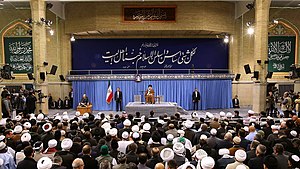Office of the Supreme Leader of Iran
 | |
 Pictured here, the Imam Khomeini Hussainiya, part of the House of Leadership, is the place where the Supreme Leader usually meets the public.[1] | |
| Agency overview | |
|---|---|
| Formed | July 1989 |
| Preceding | |
| Headquarters | Tehran, Iran 35°41′31″N 51°23′55″E / 35.69194°N 51.39861°ECoordinates: 35°41′31″N 51°23′55″E / 35.69194°N 51.39861°E |
| Agency executives |
|
| Website | www.leader.ir |
The Office of the Supreme Leader of Iran (Persian: دفتر رهبر جمهوری اسلامی ایران, Daftar-e Magham-e Moazzam-e Rahbari lit. Office of the Supreme Leadership Authority), also known as the House of Leadership (Persian: بیت رهبری, Beit-e Rahbari), is the official residence, bureaucratic office and principal workplace of the Supreme Leader of Iran[5] since 1989.
Its structure is a mixture of traditional Beit (religious office of Marja') and bureaucracy.[6] The institution is located in central Tehran[7] and is run by Mohammad Mohammadi Golpayegani.[3]
Overview[]
The Office of the Supreme Leader is used by the Supreme Leader to communicate and administer orders to various other military, cultural, economic, and political organizations. A number of political, military, and religious advisors work under this office. These advisors have an influential role in decisions made throughout country.
According to Ali Motahari, a former member of parliament from Tehran, the influence of the Office of the Supreme Leader in the country's affairs are so great that "the parliament is effectively a branch of the Office of the Supreme Leader".[8]
Sanctions[]
On June 24, 2019, U.S. President Donald Trump signed Executive Order 13876, in which the assets of the Office of the Supreme Leader of Iran, along with Ali Khamenei, are frozen following the incident near the Gulf of Oman in the days prior.[9][10]
See also[]
- Ruhollah Khomeini's residency (Jamaran), similar compound of the previous supreme leader
References[]
- ^ "Supreme Leader receives people at Imam Khomeini Mosque". Islamic Republic News Agency (IRNA). 9 September 2015. 81753490 (4864870). Archived from the original on 22 August 2016. Retrieved 28 March 2016.
- ^ Mohammad Hamid Ansari, ed. (2005). Iran today: twenty-five years after the Islamic revolution. ORF studies of contemporary Muslim societies. 3. Rupa & Co. pp. 213, 217.
- ^ a b c Sahimi, Muhammad (29 May 2013). "The Death of the Iranian Revolution". National Interest. Retrieved 28 March 2016.
- ^ "Army Unveils Book on Supreme Leader's Remarks about Military Self-Sufficiency". Fars News Agency. 15 December 2014. Retrieved 28 March 2016.
- ^ Dickey, Cristopher (19 July 2009). "Ayatollah Khamenei's Journey". Newsweek. Retrieved 28 March 2016.
- ^ Brumberg, Daniel; Farhi, Farideh (2016). "Role of The Office of Supreme Leader". Power and Change in Iran: Politics of Contention and Conciliation. Indiana Series in Middle East Studies. Indiana University Press. pp. 150–151. ISBN 978-0253020796.
- ^ Richter, Paul (14 July 2015). "Key, secret concessions opened the way for Iran nuclear deal". LA Times. Retrieved 28 March 2016.
- ^ Iran supreme leader office network radiofarda.com
- ^ reuters.com: Trump puts sanctions on Iranian supreme leader other top officials 24 June 2019. By Steve Holland and Stephen Kalin.
- ^ treasury.gov: resource center/sanctions/OFAC Enforcement[failed verification]
External links[]
- Buildings and structures in Tehran
- Official residences in Iran
- 1989 establishments in Iran
- Iranian entities subject to the U.S. Department of the Treasury sanctions
- Ali Khamenei
- Revolutionary institutions of the Islamic Republic of Iran
